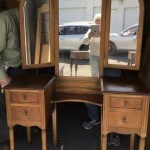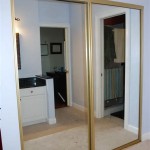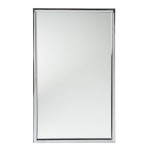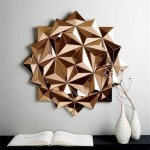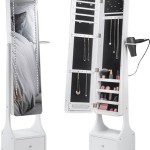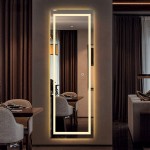Do Mirrors Make You Look Smaller?
The question of whether mirrors make one appear smaller is a common misconception often rooted in the experience of trying on clothes in fitting rooms. However, a standard, flat mirror, by definition, reflects a perfect, albeit reversed, image. The perceived size difference isn't due to the mirror itself but rather a combination of psychological and environmental factors.
Key Factors Influencing Perceived Size in Mirrors:
Several elements contribute to why individuals might feel they appear smaller or larger in mirrors compared to photographs or other people's perceptions:
* **Distance:** Proximity to the mirror plays a significant role. Standing closer makes features appear larger, while stepping further away diminishes the overall image. * **Angle:** The viewing angle can distort the reflected image. Tilting the mirror upwards or downwards can elongate or compress the reflection, respectively. * **Lighting:** Different lighting conditions impact how shadows and highlights fall on the body, affecting the perceived shape and size. * **Type of Mirror:** While standard mirrors offer a true reflection, funhouse mirrors intentionally distort the reflected image, altering proportions and creating a skewed perception of size.The Psychology of Self-Image:
Beyond the physical properties of mirrors and light, psychological factors significantly influence how individuals interpret their reflections. Body dysmorphia, a mental health condition, can lead to a distorted perception of one's body image, often making individuals feel larger or smaller than they are, regardless of the reflection's accuracy.
Body Dysmorphia and Mirror Perception:
Body dysmorphia can manifest in various ways, causing individuals to fixate on perceived flaws in their appearance. This fixation can lead to anxiety and distress when looking in the mirror, further skewing their perception of their size. Professional guidance is crucial for managing body dysmorphia and developing a healthier body image.
The Camera Lens and Perspective Distortion:
Photographs, unlike mirrors, introduce another layer of complexity: lens distortion. Different lenses can alter the perceived size and proportions of the subject. Wide-angle lenses, for example, can make objects closer to the lens appear larger and distort straight lines, while telephoto lenses compress perspective, making objects appear closer together and potentially altering perceived size. The photographer's choice of lens and positioning can significantly influence the final image.
Focal Length and its Impact on Perceived Size:
The focal length of a camera lens directly impacts how the subject is captured. Shorter focal lengths (wide-angle lenses) tend to exaggerate perspective and distort features, particularly at close range. Longer focal lengths (telephoto lenses) compress the perspective, making features appear proportionally smaller and closer together. This compression effect can sometimes create a slimming illusion, contributing to the perception that one looks different in photographs compared to mirror reflections.
The "Fitting Room Effect":
The infamous "fitting room effect" describes the phenomenon where individuals frequently feel they appear larger in fitting room mirrors than in mirrors at home. This perception can be attributed to various factors, including:
* **Unflattering Lighting:** Fitting rooms often employ harsh, direct lighting that accentuates imperfections and can create unflattering shadows, making individuals feel self-conscious about their size. * **Close Proximity to the Mirror:** The limited space in fitting rooms often necessitates standing closer to the mirror, which, as previously mentioned, can make features appear larger. * **Psychological Pressure:** The act of trying on clothes, particularly in anticipation of a special occasion, can induce stress and anxiety, further skewing self-perception and contributing to feelings of self-consciousness about body size.Mirrors and Three-Dimensional Perception:
Understanding how humans perceive three-dimensional space is crucial for deciphering why mirrors might sometimes create illusions related to size. Our brains constantly interpret visual cues to determine depth and distance. When looking in a mirror, the reversed image can slightly disrupt this process, especially when combined with other factors like lighting and angle.
Mirrors as Tools for Self-Assessment:
While mirrors can be subject to perceptual distortions, they remain valuable tools for self-assessment. By being aware of the potential influences on perception, individuals can utilize mirrors effectively to monitor changes in their physique, assess posture, and gain a more objective understanding of their appearance.

Why Do I Look Diffe In Mirrors 5 Common Reasons

Why Do I Look Diffe In Mirrors 5 Common Reasons

Are Skinny Mirrors Being Used In Popular Retailers Dressing Rooms I Decided To Find Out

New Skinny Mirror Makes You Look 10 Pounds Thinner
Here S How Skinny Mirrors Trick Women Into More Clothes

Proof You Do Look Diffe In Every Changing Room Mirror Amanda Platell Writes Daily Mail
Why Do Some Mirrors Make You Look More Attractive Than Other And Which One To Trust Quora

Why Do I Look Diffe In Mirrors 5 Common Reasons

Fuming Woman Accuses High Street Chain H M Of Using Curved Mirrors That Make Customers Look Fatter The Sun
Why Do We Look Fitter In Gym Mirrors Quora

